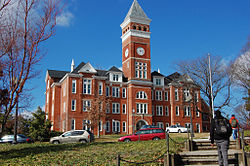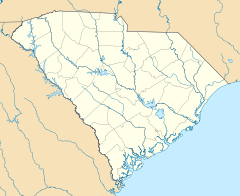- Clemson University Historic District II
-
Not to be confused with Clemson University Historic District I.Clemson University Historic District II
Location: Center of campus, Clemson, South Carolina Coordinates: 34°40′40″N 82°50′18″W / 34.67778°N 82.83833°WCoordinates: 34°40′40″N 82°50′18″W / 34.67778°N 82.83833°W Area: 15 acres (6.1 ha) Built: 1803–1940 Architect: Rudolph E. Lee Architectural style: Renaissance Revival, Queen Anne, Art Deco Governing body: State MPS: Clemson University MPS NRHP Reference#: 89002139[1] Added to NRHP: January 4, 1990 The Clemson University Historic District II is a collection of historic properties on the campus of Clemson University in Clemson, South Carolina. The district contains 7 contributing properties located in the central portion of the campus.[2] It was listed on the National Register of Historic Places in 1990.[1]
Contributing properties
Building Photo Built Location Notes John C. Calhoun Office 
circa 1825 34°40′39.5″N 82°50′20.3″W / 34.677639°N 82.838972°W John C. Calhoun's office on the premises of his Fort Hill estate served as his private library. Its Greek Revival style echoes that of the main house.[3] Fort Hill 
circa 1803 34°40′40.6″N 82°50′20.2″W / 34.677944°N 82.838944°W John C. Calhoun purchased the plantation & house in 1825. It was passed to his daughter, Anna, and son-in-law Thomas Green Clemson. Clemson willed the land to the State to be used for a public university. It was individually listed as a National Historic Landmark in 1960.[3] Hardin Hall 
1890 34°40′41.8″N 82°50′12.9″W / 34.678278°N 82.836917°W Hardin Hall is the oldest academic building on campus. It was originally built as the Chemistry laboratory, it was expanded in 1900 and 1937, and has housed the Education department and administration offices.[3] It currently houses the departments of History, Philosophy, and Religion. Outdoor Theater 
1940 34°40′41.7″N 82°50′10.0″W / 34.67825°N 82.83611°W The Outdoor Theater was built as a gift of the Class of 1915, and designed by one of its members and the university's first architecture graduate, Leon LeGrand. The Art Deco stage was nearly demolished and replaced in 1977, but protests prompted its renovation and the addition of concrete terraced seating.[3] Riggs Hall 
1927 34°40′37.2″N 82°50′16.4″W / 34.677°N 82.837889°W Riggs Hall was built to replace Mechanical Hall, which burned in 1926. It was designed by Architecture department chairman Rudolph E. Lee. The departments of Architecture, Civil Engineering, Electrical Engineering, and Mechanical Engineering were the first tenants. Architecture and Civil Engineering moved into the new Structural Science Building in 1958, but Electrical and Mechanical Engineering are still located in the building.[3] Sirrine Hall 
1938 34°40′37.4″N 82°50′21.5″W / 34.677056°N 82.839306°W Sirrine Hall was built to replace Godfrey Hall as the Textile building. It was one of 8 buildings built between 1936 and 1938, and designed by Rudolph E. Lee in an Italian Renaissance Revival style.[3] Today, the building houses the College of Business. Trustee House 
1904 34°40′42.3″N 82°50′17.1″W / 34.678417°N 82.838083°W The Trustee House was originally the home of Chemistry department chairman Mark B. Hardin. After his death, the Board of Trustees used it for meetings, and visiting dignitaries stayed in the house.[3] See also
- Clemson University Historic District I
- Campus of Clemson University
References
- ^ a b "National Register Information System". National Register of Historic Places. National Park Service. 2009-03-13. http://nrhp.focus.nps.gov/natreg/docs/All_Data.html.
- ^ "Clemson University Historic District II". National Register Properties in South Carolina. South Carolina Department of Archives and History. http://www.nationalregister.sc.gov/pickens/S10817739006/index.htm. Retrieved 20 May 2011.
- ^ a b c d e f g Davis, Martin A.; Edwards, John (31 May 1988). "Clemson University Historic District II". National Register of Historic Places Registration Form. National Park Service. Archived from the original on 22 May 2011. http://www.webcitation.org/5yriprXEa. Retrieved 22 May 2011.
U.S. National Register of Historic Places in South Carolina Lists by county Abbeville • Aiken • Allendale • Anderson • Bamberg • Barnwell • Beaufort • Berkeley • Calhoun • Charleston • Cherokee • Chester • Chesterfield • Clarendon • Colleton • Darlington • Dillon • Dorchester • Edgefield • Fairfield • Florence • Georgetown • Greenville • Greenwood • Hampton • Horry • Jasper • Kershaw • Lancaster • Laurens • Lee • Lexington • Marion • Marlboro • McCormick • Newberry • Oconee • Orangeburg • Pickens • Richland • Saluda • Spartanburg • Sumter • Union • Williamsburg • York

Lists by city Other lists Keeper of the Register • History of the National Register of Historic Places • Property types • Historic district • Contributing property Clemson University Academics Schools and Institutes: Clemson University Graduate School • Clemson University International Center for Automotive Research • Calhoun Honors College

Athletics ACC • Tiger Rag • Baseball (2010 • Coach • Stadium) • Basketball (2009-10 • Coach • Coliseum) • Football (2009 • Coach • Stadium) • Soccer (Coach) • Rugby • Carolina-Clemson rivalry • Clemson Tigers Sports Network • O'Rourke–McFadden Trophy • Riggs Field • South Carolina-Clemson brawl • The Bowden Bowl • Textile Bowl
Campus Clemson College Sheep Barn • Fort Hill • Fike Recreation Center • City of Clemson • Hanover House • Images • Johnstone Hall • Lee and Lowry Hall • South Carolina Botanical Garden • Old Stone Church and Cemetery • Historic District I • Historic District II
Student life People Alumni • Thomas Green Clemson • John C. Calhoun • Benjamin Tillman • James F. Barker
Categories:- Historic districts in South Carolina
- National Register of Historic Places in Pickens County, South Carolina
- Victorian architecture in the United States
- Clemson University campus
- Schools on the National Register of Historic Places in South Carolina
- South Carolina Registered Historic Place stubs
Wikimedia Foundation. 2010.

